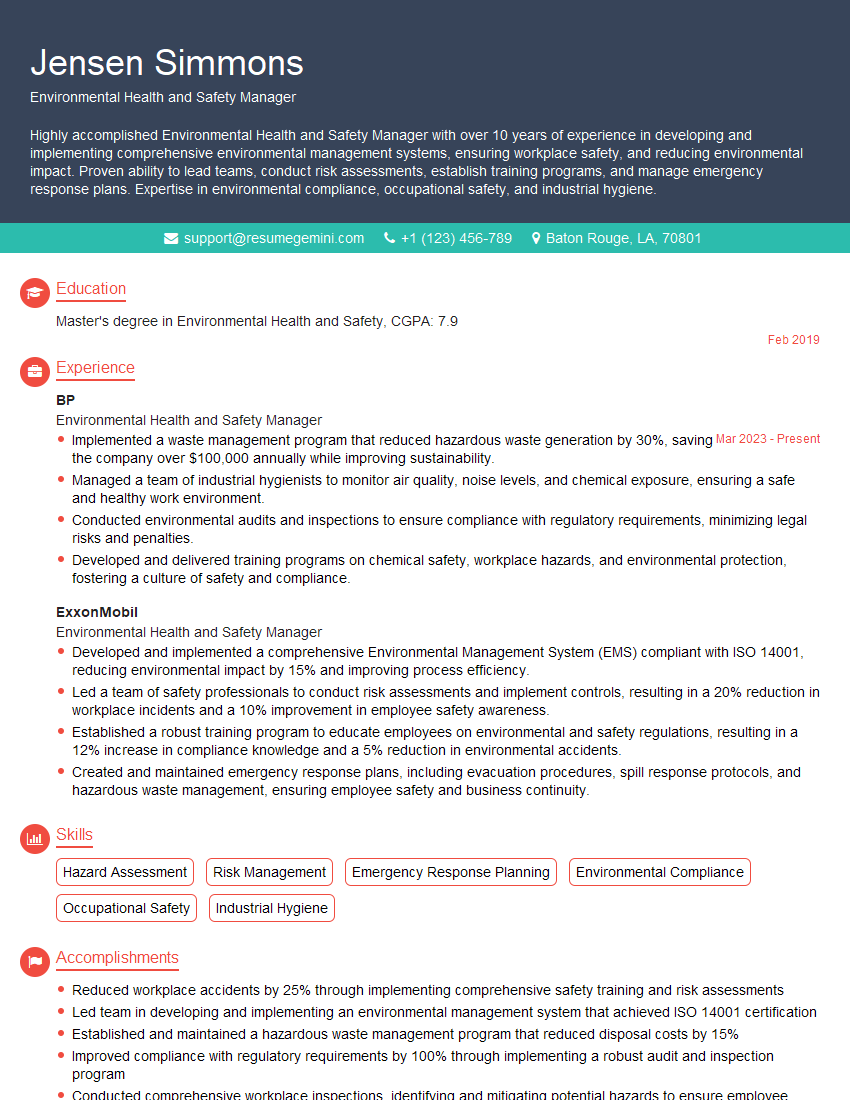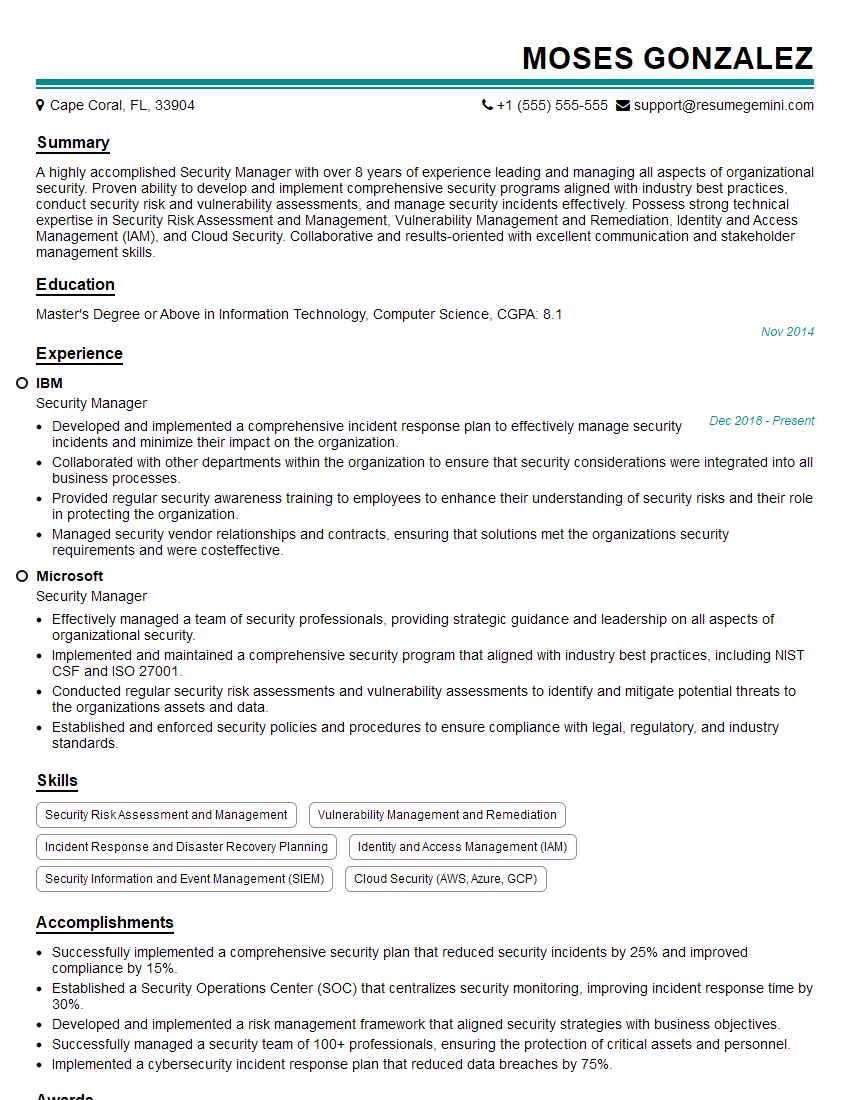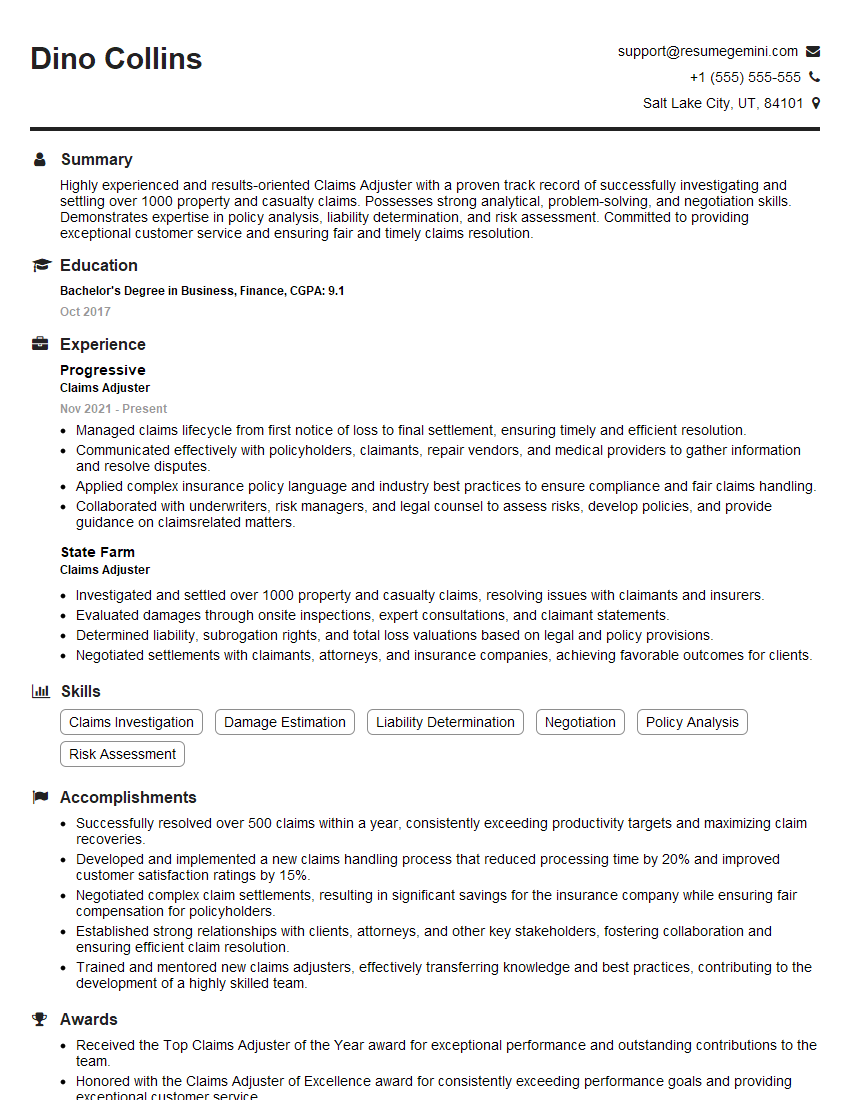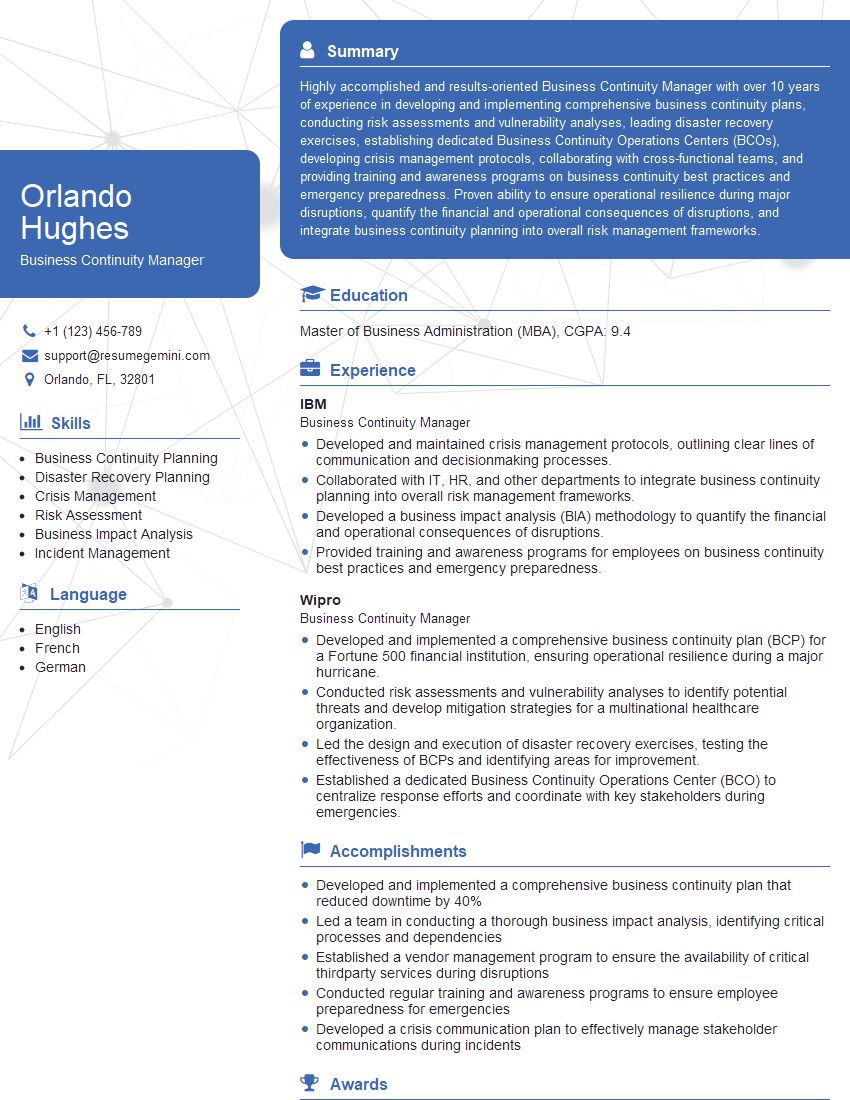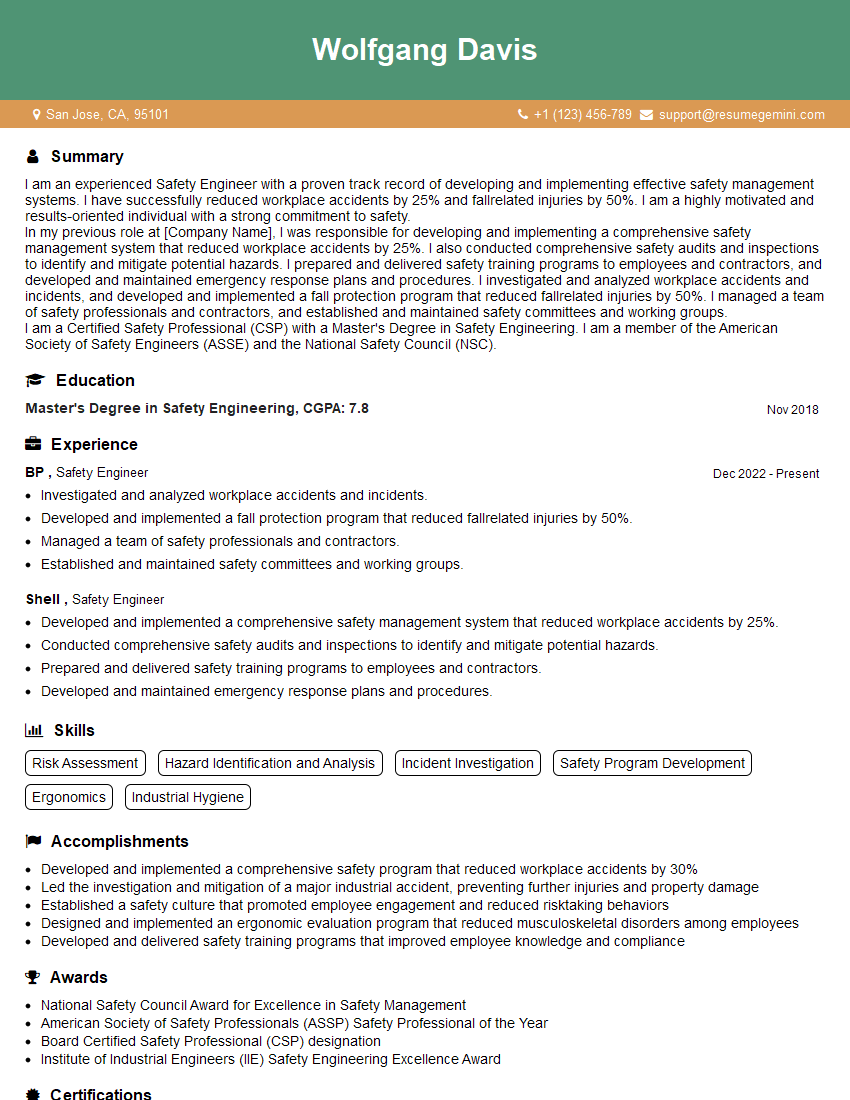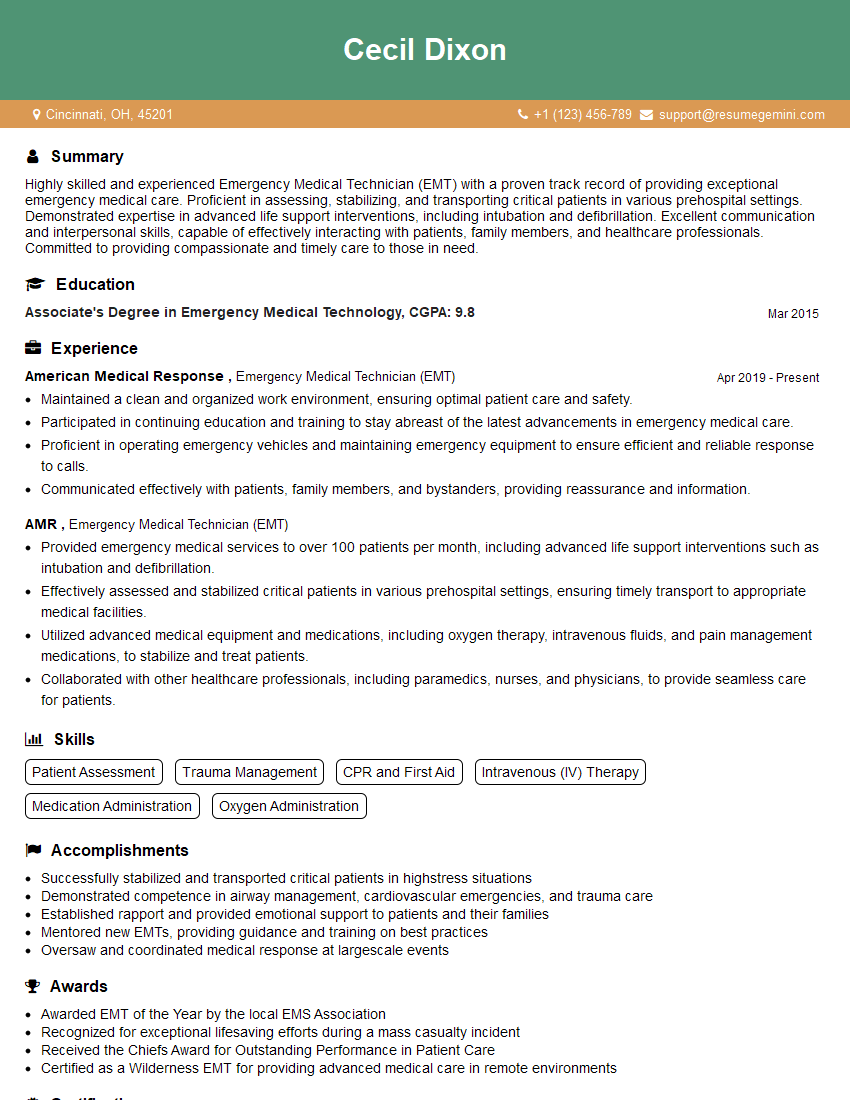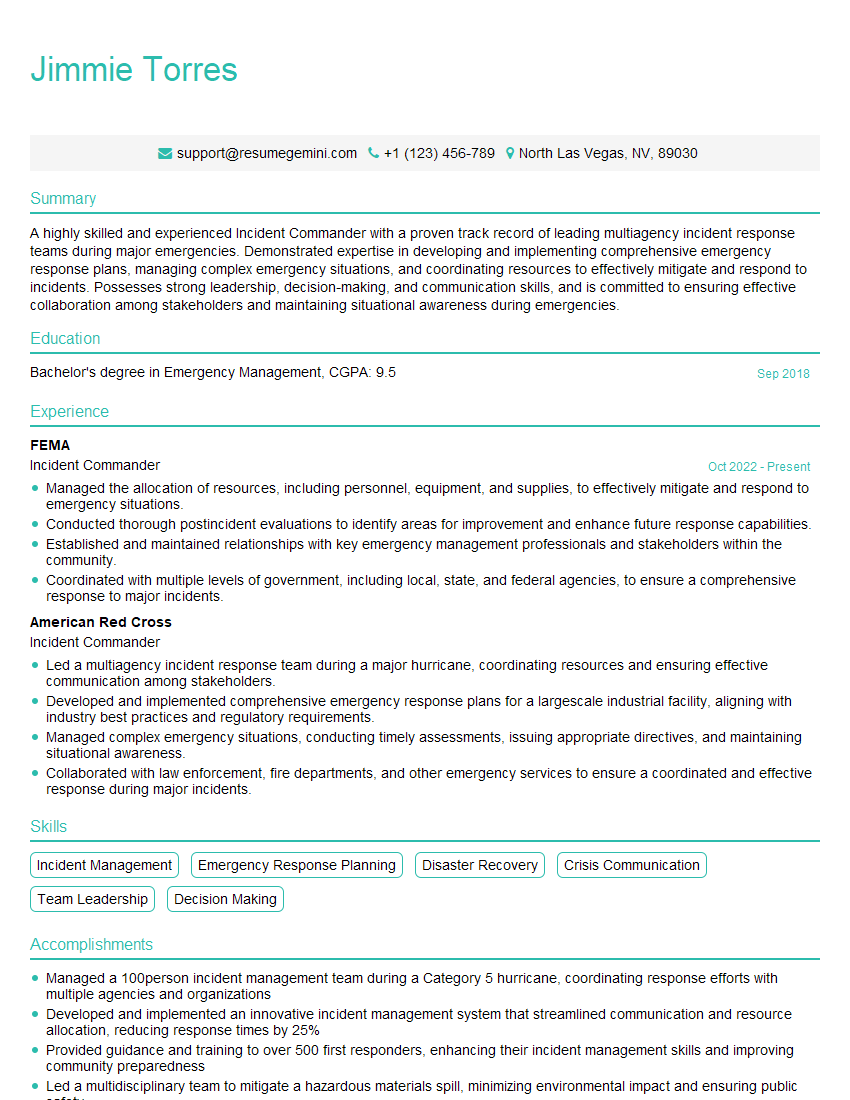Cracking a skill-specific interview, like one for Emergency Procedures and Damage Control, requires understanding the nuances of the role. In this blog, we present the questions you’re most likely to encounter, along with insights into how to answer them effectively. Let’s ensure you’re ready to make a strong impression.
Questions Asked in Emergency Procedures and Damage Control Interview
Q 1. Describe your experience developing and implementing emergency procedures.
Developing and implementing emergency procedures involves a systematic approach that prioritizes preparedness and effective response. It starts with a thorough hazard analysis, identifying potential threats specific to the environment and operation. This could range from natural disasters like hurricanes or earthquakes to equipment malfunctions or security breaches. Following this, I develop detailed, step-by-step procedures for each identified hazard. These procedures are not just written documents; they are meticulously tested through tabletop exercises and drills, allowing for continuous refinement and improvement. For example, in my previous role at a large chemical plant, we developed evacuation plans, spill response protocols, and emergency shutdown procedures. Each procedure was documented in clear, concise language, incorporating visuals such as maps and flowcharts for easy understanding under pressure. Regular training sessions ensured all personnel were familiar with their roles and responsibilities, promoting seamless execution during a real emergency.
Q 2. Explain your process for assessing risk and prioritizing emergency responses.
Risk assessment is crucial for prioritizing emergency responses. I use a combination of qualitative and quantitative methods. Qualitative methods, such as brainstorming sessions and HAZOP (Hazard and Operability) studies, identify potential hazards and their likelihood. Quantitative methods, including Failure Mode and Effects Analysis (FMEA) and risk matrices, assign numerical values to the likelihood and severity of each hazard. This allows us to prioritize responses based on a calculated risk score. For instance, a high-probability, high-consequence event like a major fire would receive immediate attention and resource allocation, whereas a low-probability, low-consequence event might receive less immediate attention, but still be included in the overall emergency plan. This process also involves considering available resources, personnel expertise, and the potential impact on operations and the surrounding community.
Q 3. How do you communicate effectively during a crisis?
Effective communication during a crisis is paramount. It involves using multiple channels to ensure message clarity and reach. I utilize a multi-layered communication strategy, combining pre-established communication trees with readily available technologies. Clear, concise messaging is key. Avoid technical jargon and utilize plain language. For example, during a major incident, I would leverage a combination of:
- Pre-determined communication trees: Ensuring specific individuals receive timely information based on their roles and responsibilities.
- Two-way radios: For real-time updates and immediate action commands in the field.
- Public address systems: For disseminating important information to a larger audience.
- Text and email alerts: For broader notification and dissemination of updates.
Q 4. What methods do you use to coordinate teams during an emergency?
Coordinating teams during an emergency relies on clear roles, responsibilities, and established communication protocols. I use incident command systems (ICS), a standardized, flexible framework designed to manage complex emergencies. ICS divides roles and responsibilities into functional areas (e.g., command, operations, logistics, finance). Each area is headed by a designated leader, fostering clear accountability. Regular team training, utilizing ICS structure and protocols, creates a unified response. For instance, during a large-scale oil spill, the ICS framework allowed us to effectively manage the clean-up operation, assigning tasks to different teams: one for containment, another for cleanup, and a third for public relations and environmental monitoring. This organized approach streamlined efforts, leading to a more efficient and effective response.
Q 5. Describe a time you had to make a critical decision under pressure during an emergency.
During a chemical spill at a manufacturing plant, I had to make a rapid decision under immense pressure. Initial assessments indicated a potential for a large-scale environmental disaster. The conflicting priorities were to contain the spill quickly, while prioritizing the safety of the personnel involved. A faster containment method existed, but it involved potentially exposing a small team to hazardous levels of chemicals. After careful assessment, weighting the risks and benefits, I authorized the faster containment procedure, ensuring the team was equipped with advanced protective gear and strict safety protocols were implemented. This decisive action contained the spill, preventing a much larger environmental catastrophe. A post-incident review identified improvements to enhance personnel safety further in similar scenarios, highlighting the importance of continuous learning and improvement.
Q 6. How do you ensure the safety of personnel during emergency situations?
Ensuring personnel safety during emergencies is my top priority. It involves a multifaceted approach. Firstly, comprehensive safety training and regular drills are essential. This ensures all personnel know evacuation routes, emergency procedures, and the correct use of personal protective equipment (PPE). Secondly, I employ risk assessments to identify potential hazards and implement appropriate control measures. This might involve implementing physical barriers, engineering controls, or administrative procedures. Thirdly, real-time monitoring systems and communication protocols allow for quick responses to developing threats. Lastly, post-incident reviews analyze personnel safety aspects, identifying areas for enhancement. This iterative process ensures ongoing improvement in safety measures.
Q 7. What are your strategies for damage control and minimizing losses after an incident?
Damage control and loss minimization require a structured approach. Immediate actions focus on containment and stabilization. This involves securing the affected area, preventing further damage, and protecting personnel and the environment. Subsequent actions concentrate on assessment and recovery. This includes thorough damage assessment, identifying affected assets, and planning for repairs or replacements. Simultaneously, I implement measures to mitigate further losses, this may include insurance claims, contacting relevant authorities and initiating legal procedures if necessary. Finally, a thorough post-incident review helps identify the root causes, allowing for the implementation of corrective and preventative actions to avoid similar incidents in the future. This systemic approach ensures a rapid response and minimizes long-term impact.
Q 8. Explain your understanding of different types of emergency situations and their unique challenges.
Emergency situations are incredibly diverse, ranging from relatively minor incidents to catastrophic events. Understanding their unique challenges is crucial for effective response. For instance, a fire in a small office building presents different challenges than a major hurricane impacting a coastal city.
- Natural Disasters: These (hurricanes, earthquakes, floods) often involve widespread damage, mass casualties, and logistical nightmares in accessing affected areas. The unpredictable nature and sheer scale present major challenges in resource allocation and coordination.
- Industrial Accidents: Chemical spills, explosions, or structural failures in industrial settings demand specialized response teams and equipment. The potential for secondary hazards (e.g., toxic fumes) adds significant complexity.
- Terrorist Attacks or Active Shooter Events: These require immediate and decisive action, often involving law enforcement and specialized tactical teams. The threat of ongoing violence and the need to prioritize human life create intense pressure and complex decision-making scenarios.
- Medical Emergencies: Mass casualty incidents (e.g., train derailments, building collapses) require rapid triage, effective patient transport, and coordination with hospitals. Efficient resource management and communication are key to minimizing casualties.
Each type requires a tailored approach, considering factors like the scale of the event, available resources, and potential hazards. A well-trained emergency responder must be adaptable and possess a broad understanding of these different contexts.
Q 9. How do you utilize available resources (personnel, equipment, etc.) during an emergency?
Resource utilization during an emergency is a critical skill. It’s about making the best use of what you have – people, equipment, supplies – under intense time pressure and often chaotic conditions. My approach is based on the principles of situational awareness, clear communication, and efficient task delegation.
- Needs Assessment: The first step is a rapid assessment of the situation to understand immediate needs. What are the primary dangers? How many people are affected? What resources are available (both on-site and through external agencies)?
- Personnel Management: I assign roles based on individual skills and experience, ensuring clear chain of command. Effective communication is paramount; clear instructions, progress updates, and open channels are vital to avoid confusion and ensure coordinated efforts. We use standardized communication protocols like ICS (Incident Command System).
- Equipment Prioritization: This involves prioritizing equipment based on immediate needs and efficiency. For example, in a fire, firefighting equipment takes precedence; in a chemical spill, containment and decontamination tools are critical. Regular equipment checks and maintenance are crucial to ensure reliability during emergencies.
- Resource Coordination: Effective communication with external agencies (police, fire department, medical services) is crucial for coordinated response. This may involve requesting additional personnel, equipment, or specialist support.
Imagine a building fire – I’d immediately assess the number of trapped individuals, prioritize rescue efforts, allocate firefighters to tackle the blaze, and coordinate with paramedics for victim treatment. Efficient resource management, in this case, can be the difference between life and death.
Q 10. How do you conduct post-incident analyses and identify areas for improvement?
Post-incident analysis (PIA) is not just about assigning blame; it’s a crucial learning process for improving future response. It’s a systematic review designed to identify what worked well, what didn’t, and how to do things better next time.
- Data Collection: Gathering information is the first step. This includes incident reports, medical records, witness statements, damage assessments, and communication logs. The goal is to create a comprehensive picture of the event.
- Root Cause Analysis: We use techniques like the ‘5 Whys’ to identify the underlying causes of the incident. This helps move beyond surface-level observations and uncover systemic issues that need addressing.
- Strengths and Weaknesses: The PIA objectively reviews both successes and failures. What strategies were effective? Where were there communication breakdowns? Were there equipment failures or training deficiencies?
- Recommendations and Implementation: Based on findings, we formulate clear, actionable recommendations to prevent similar incidents. This might involve improved training protocols, updated emergency plans, changes to equipment, or enhanced communication systems. Implementation and follow-up are critical to ensure lasting improvements.
For example, following a chemical spill, a PIA might reveal a lack of proper safety training leading to incorrect handling procedures. The recommendation could then be to implement mandatory refresher training programs and update safety protocols.
Q 11. Describe your experience with emergency response training and drills.
Emergency response training and drills are essential for preparedness. My experience encompasses various types of training, from classroom instruction to large-scale simulations. I’ve participated in numerous drills involving diverse scenarios like fire evacuations, hazardous material spills, and active shooter responses.
- Classroom Training: This involves theoretical instruction on emergency procedures, safety regulations, and hazard identification. It covers topics like first aid, CPR, and the use of specialized equipment.
- Hands-on Simulations: These are crucial for practicing emergency response techniques. Simulated scenarios allow teams to practice coordination, communication, and decision-making under realistic conditions, often in specialized training facilities.
- Tabletop Exercises: These involve group discussions of hypothetical scenarios, allowing for in-depth review of plans and procedures without the resource investment of a full-scale simulation.
- Full-Scale Drills: These are comprehensive simulations that often involve multiple agencies and large numbers of participants. They provide a valuable assessment of the effectiveness of existing plans and the ability of teams to respond under pressure.
These drills aren’t just about ticking boxes; they’re about building muscle memory and teamwork, ensuring that when a real emergency strikes, we’re not just reacting, but acting decisively and effectively.
Q 12. How familiar are you with relevant safety regulations and compliance standards?
Familiarity with relevant safety regulations and compliance standards is paramount in my field. These regulations vary depending on location and industry, but my knowledge encompasses several key areas.
- OSHA (Occupational Safety and Health Administration): I’m well-versed in OSHA’s requirements for workplace safety, including emergency action plans, hazard communication, and personal protective equipment (PPE).
- NFPA (National Fire Protection Association): My understanding of NFPA standards is extensive, covering topics like fire prevention, fire suppression, and emergency response procedures.
- Local and State Regulations: I’m familiar with local and state regulations related to emergency response, including building codes, environmental regulations, and reporting requirements.
- Industry-Specific Standards: Depending on the context, I’m also familiar with industry-specific safety standards. For instance, in the chemical industry, I’d be well-versed in relevant HAZMAT (Hazardous Materials) regulations.
Compliance is not just about avoiding penalties; it’s about ensuring a safe work environment and reducing the risk of accidents and injuries. Staying updated on the latest regulations is an ongoing process requiring continual professional development.
Q 13. How do you handle conflicting priorities during an emergency response?
Conflicting priorities are a common occurrence during emergency responses. The ability to make difficult decisions under pressure is critical. My approach focuses on prioritizing based on the most significant threat to life and property.
- Prioritization Matrix: I use a prioritization matrix to weigh different factors. This might involve a simple scale considering the number of lives at risk, the severity of the threat, and the potential for escalation.
- Risk Assessment: A thorough risk assessment helps determine which actions will have the greatest impact in mitigating the most significant risks. It’s about focusing on the highest probability and highest consequence threats.
- Communication and Collaboration: Open communication with all involved parties is crucial. Transparency about the decision-making process and the rationale behind the priorities helps foster collaboration and buy-in.
- Flexibility and Adaptability: The situation is constantly evolving. Therefore, the initial priorities may need adjustments as new information becomes available. The ability to adapt to changing circumstances is essential.
For instance, during a large-scale incident, you might need to decide between deploying resources to evacuate a building and tackling a spreading fire. A proper risk assessment and a clear understanding of the situation will guide this decision, emphasizing the protection of human life first.
Q 14. What are your strategies for preventing future incidents?
Preventing future incidents involves a multi-faceted approach, focusing on proactive measures and continuous improvement.
- Hazard Identification and Risk Assessment: Regularly reviewing and updating hazard assessments and risk profiles is crucial. This involves identifying potential threats, analyzing their likelihood and consequences, and developing mitigation strategies.
- Improved Safety Procedures and Training: Strengthening safety procedures and providing comprehensive training for all personnel are key. This ensures employees have the knowledge and skills to identify and respond to hazards appropriately.
- Regular Inspections and Maintenance: Regular inspections of equipment and facilities help identify and address potential problems before they escalate into major incidents. Preventive maintenance plays a significant role in preventing equipment failures.
- Emergency Preparedness Plans: Having well-developed and regularly updated emergency preparedness plans is essential. These plans must cover various scenarios, communication protocols, and resource allocation strategies. Regular drills are necessary to ensure everyone understands their roles and responsibilities.
- Data Analysis and Lessons Learned: Using data analysis from past incidents to identify trends and patterns is critical. This allows for targeted interventions to address systemic vulnerabilities and weaknesses.
For example, if a series of minor accidents occur in a particular area, a thorough investigation could reveal an underlying safety issue, leading to a redesign of the workspace or the implementation of new safety protocols.
Q 15. Describe your experience with crisis communication and stakeholder management.
Effective crisis communication and stakeholder management are paramount in emergency situations. My experience involves crafting and disseminating clear, concise, and timely information to a wide range of stakeholders, including employees, clients, the public, and regulatory bodies. This includes establishing communication channels, utilizing various media (e.g., press releases, social media, internal memos), and proactively addressing concerns and misinformation. For instance, during a major chemical spill incident at a previous employer, I led the communication effort, providing regular updates to the affected community via town halls, press conferences, and website updates. This involved carefully managing expectations, addressing anxieties, and ensuring transparency, ultimately minimizing public panic and fostering trust.
Stakeholder management requires understanding the needs and concerns of each group. I actively build relationships with key stakeholders before, during, and after an event. This allows for proactive engagement and ensures everyone is informed and feels heard. During a factory fire, for example, I prioritized communication with first responders, local authorities, and employees’ families, ensuring they received the most relevant, timely, and accurate information. My approach includes regular feedback loops and adaptability to changing circumstances. This proactive and responsive communication strategy proved crucial in minimizing disruptions and negative impacts.
Career Expert Tips:
- Ace those interviews! Prepare effectively by reviewing the Top 50 Most Common Interview Questions on ResumeGemini.
- Navigate your job search with confidence! Explore a wide range of Career Tips on ResumeGemini. Learn about common challenges and recommendations to overcome them.
- Craft the perfect resume! Master the Art of Resume Writing with ResumeGemini’s guide. Showcase your unique qualifications and achievements effectively.
- Don’t miss out on holiday savings! Build your dream resume with ResumeGemini’s ATS optimized templates.
Q 16. How do you maintain composure and manage stress during high-pressure situations?
Maintaining composure under pressure is a skill honed over years of experience. I employ several techniques, including deep breathing exercises, mindfulness, and a structured approach to problem-solving. Before any potentially stressful event, I mentally rehearse the situation and possible scenarios, ensuring I’m prepared for various contingencies. This helps me anticipate challenges and develop strategies to handle them calmly. When the pressure is on, my training kicks in: I focus on the task at hand, prioritize actions based on their impact, and delegate effectively to leverage the skills of my team. Think of it like a conductor of an orchestra; each individual has a role, and coordination is key to a successful outcome.
Moreover, I’m a strong believer in self-care. Adequate rest, a balanced diet, and regular exercise are crucial for maintaining physical and mental resilience. The ability to manage stress effectively minimizes errors, improves decision-making, and fosters a calm and supportive environment for the entire team.
Q 17. Explain your understanding of incident command systems.
Incident Command Systems (ICS) are standardized, on-scene, all-hazards incident management systems used to manage emergencies. They provide a framework for organizing, controlling, and coordinating emergency response resources effectively. ICS operates under a hierarchical structure, with clearly defined roles and responsibilities. Key positions include the Incident Commander, responsible for overall management; Operations Section Chief, managing tactical operations; Planning Section Chief, responsible for information gathering and strategic planning; Logistics Section Chief, managing resources; and Finance/Administration Section Chief, managing financial aspects.
My experience with ICS spans various large-scale incidents, including natural disasters and industrial accidents. I understand the importance of clear communication, resource allocation, and accountability within the ICS structure. Effective utilization of ICS ensures a coordinated, efficient response, minimizes duplication of efforts, and enhances overall safety.
Q 18. How do you ensure continuity of operations during and after an emergency?
Ensuring continuity of operations during and after an emergency is critical. This involves developing robust business continuity plans that address potential disruptions to operations, technology, and critical infrastructure. These plans should outline procedures for data backup and recovery, alternate work locations, and communication protocols. Prior to any emergency, we conduct regular drills and training exercises to test and refine our plans. This allows us to identify weaknesses and implement improvements proactively.
During an emergency, our focus is on minimizing disruptions and ensuring the safety of personnel. This may involve implementing alternate operational processes, activating backup systems, and utilizing remote work capabilities. Post-emergency, our efforts center on damage assessment, recovery operations, and a thorough review of our response to identify lessons learned and areas for improvement. A recent example involved a cyberattack that temporarily disrupted our systems; our business continuity plan, coupled with our thorough preparation, ensured a quick recovery with minimal disruption to service.
Q 19. What is your experience with emergency response planning and preparedness?
My experience in emergency response planning and preparedness includes developing and implementing comprehensive plans for various scenarios, from natural disasters (e.g., earthquakes, floods) to technological failures (e.g., power outages, cyberattacks). This involves conducting risk assessments, identifying vulnerabilities, and developing mitigation strategies. These plans detail roles and responsibilities, communication protocols, evacuation procedures, and resource allocation. I’ve led numerous training exercises and simulations to ensure preparedness, and I’m well-versed in relevant regulations and standards.
The development of comprehensive emergency plans is an iterative process. They require regular review and updates based on changing conditions and lessons learned from past events. A key part of this is conducting regular tabletop exercises and full-scale drills. These simulations allow us to identify areas that need improvement and to ensure that everyone on the team is prepared to react in a coordinated and efficient manner.
Q 20. How do you measure the effectiveness of your emergency procedures?
Measuring the effectiveness of emergency procedures involves both quantitative and qualitative assessment. Quantitative measures include response times, resource utilization, and the number of injuries or fatalities. Qualitative measures include evaluating the effectiveness of communication, coordination among response teams, and the overall efficiency of the response. Post-incident reviews, including surveys and feedback sessions with involved personnel, are crucial for gathering insights.
We utilize several tools, including after-action reports and key performance indicators (KPIs), to assess the effectiveness of our emergency response. Data analysis helps identify areas of strength and weakness, guiding improvements to our plans and procedures. For example, after a recent building evacuation drill, we analyzed the data to identify bottlenecks and improve our communication protocols, leading to a more efficient evacuation process in future drills.
Q 21. Describe your experience with evacuation procedures and protocols.
My experience with evacuation procedures and protocols includes developing and implementing plans for various scenarios, considering building layouts, potential hazards, and the needs of diverse populations (e.g., individuals with disabilities). These plans include designated assembly points, communication systems, and procedures for accounting for personnel. Regular drills and training are conducted to familiarize staff and occupants with evacuation routes and procedures.
Evacuation procedures need to be tailored to the specific environment and risks involved. For example, a high-rise building will have different evacuation considerations than a low-rise building. The plan should account for special needs and incorporate accessibility features. A successful evacuation procedure requires clear signage, well-marked escape routes, trained personnel, and regular practice. We also incorporate regular reviews and adjustments based on lessons learned from drills and real-world incidents.
Q 22. How do you handle media inquiries during a crisis?
Handling media inquiries during a crisis requires a structured, proactive approach. It’s crucial to establish a designated spokesperson who is well-informed, calm, and capable of delivering consistent messaging. We utilize a pre-prepared media response plan that outlines key messages, designated contact points, and approved talking points. This ensures consistent and accurate information is disseminated, minimizing confusion and speculation. For example, during a chemical spill incident, our spokesperson delivered concise updates on the containment efforts, environmental impact, and public safety measures, preventing panic and misinformation.
We prioritize transparency while safeguarding sensitive information. We use a tiered approach, providing general information to the public, and more detailed updates to relevant authorities. This controlled flow of information maintains trust and allows for efficient crisis management. After the initial crisis response, a formal post-incident review of media relations is undertaken to identify improvements and areas requiring modification for future events.
Q 23. What is your experience with various emergency response technologies?
My experience encompasses a wide range of emergency response technologies. I’m proficient in using Geographic Information Systems (GIS) for mapping incidents and deploying resources effectively. We utilize sophisticated communication systems, including dedicated radio frequencies and satellite communication for reliable connectivity in remote or affected areas.
Furthermore, I’m experienced with predictive modeling software that helps anticipate the potential spread of hazards like wildfires or chemical leaks. We also use real-time data analytics platforms to monitor various parameters during an incident, including weather conditions, traffic flow, and resource availability, aiding decision-making. For example, using real-time data analytics during a flooding event allowed us to efficiently deploy evacuation resources to the most vulnerable areas based on flood depth and population density.
Q 24. How do you work with external agencies during an emergency response?
Collaboration with external agencies is fundamental to effective emergency response. We establish clear communication channels and protocols, including pre-incident agreements, defining roles and responsibilities for each agency. This might include fire departments, police, medical services, environmental protection agencies, and even private sector companies with relevant expertise.
For example, during a major building collapse, we coordinated closely with the fire department for search and rescue, the police for crowd control and securing the scene, and medical services for triage and transport of casualties. Regular joint training exercises and drills ensure seamless inter-agency cooperation and a smooth transition between teams during real emergencies. A clear command structure, often involving an incident commander, helps prevent conflicting instructions and streamlines operations. Post-incident debriefs allow all involved agencies to review the response, identify areas for improvement, and enhance future collaborations.
Q 25. Describe your experience with safety audits and inspections.
My experience with safety audits and inspections includes conducting regular assessments of facilities and operations to identify potential hazards and ensure compliance with safety regulations. This involves reviewing safety procedures, inspecting equipment, evaluating risk levels, and ensuring the proper training of personnel. I’m skilled in identifying potential failure points and recommending corrective actions to mitigate risks.
For instance, a recent audit of a manufacturing plant revealed a lack of proper ventilation in a chemical storage area. This was immediately addressed by installing new ventilation systems to reduce the risk of fire or explosion. The process involves documenting findings, suggesting improvements, and ensuring management implements the necessary changes. Follow-up inspections verify that corrective actions have been implemented effectively.
Q 26. How do you ensure compliance with relevant legal and regulatory requirements?
Ensuring compliance with relevant legal and regulatory requirements is paramount. This necessitates a thorough understanding of all applicable laws, standards, and codes related to emergency preparedness and response. We maintain a comprehensive compliance program, involving regular reviews of regulations, updates to procedures, and documentation of all compliance activities.
For example, we meticulously maintain records of safety training, emergency drills, and equipment inspections, ensuring everything is logged and auditable. We regularly attend industry conferences and workshops to remain updated on the latest legislation and best practices. Proactive monitoring and regular self-assessments help us identify potential compliance gaps and address them swiftly.
Q 27. Explain your approach to developing and updating emergency response plans.
Developing and updating emergency response plans is an iterative process. It starts with a comprehensive risk assessment, identifying potential hazards and their likelihood. Then, we formulate response strategies tailored to each scenario. These plans outline procedures for communication, evacuation, resource allocation, and post-incident recovery.
The plans aren’t static; we regularly review and update them based on lessons learned from past incidents, changes in regulations, or new technology. We conduct drills and tabletop exercises to test the plans, identify weaknesses, and refine procedures. For example, a recent update to our hurricane preparedness plan included new evacuation routes and shelter locations based on population growth and improved infrastructure. This iterative approach ensures that our emergency response plans remain current, effective, and relevant.
Q 28. Describe a situation where your quick thinking prevented a major incident.
During a large-scale power outage at a chemical processing facility, I noticed a critical lapse in the emergency shutdown procedure. The automated system had failed, and the manual backup was unclear and inadequate. Quickly recognizing the potential for a major chemical release, I initiated an immediate temporary shutdown using a less conventional, yet safe method, based on my in-depth understanding of the facility’s systems.
This prevented a catastrophic chemical leak and potential harm to workers and the surrounding community. This incident highlighted the importance of comprehensive risk assessments that consider not only the primary safety mechanisms but also the potential failure modes of those mechanisms and the need for robust backup procedures. It emphasized the role of anticipating unlikely scenarios and preparing contingencies, emphasizing the need for quick thinking and decisive action in high-pressure situations.
Key Topics to Learn for Emergency Procedures and Damage Control Interview
- Emergency Response Planning: Understanding the development and implementation of comprehensive emergency plans, including risk assessment, resource allocation, and communication protocols.
- Incident Command System (ICS): Demonstrating knowledge of ICS principles and their practical application in managing emergency situations, including roles, responsibilities, and communication structures.
- Hazard Identification and Risk Assessment: Articulating the process of identifying potential hazards, assessing their risks, and developing mitigation strategies. This includes understanding various hazard types and their potential impact.
- Emergency Procedures & Protocols: Familiarity with specific procedures for handling various emergencies (e.g., fire, medical emergencies, hazardous material spills), and the ability to explain the rationale behind them.
- Damage Control Strategies: Understanding techniques for minimizing damage and loss during and after an emergency, including containment, repair, and recovery methods. This may include structural damage control, equipment safeguarding, and environmental protection.
- Communication & Coordination: Highlighting the importance of effective communication and coordination among team members, supervisors, and external stakeholders during an emergency.
- Post-Incident Analysis & Reporting: Demonstrating an understanding of conducting thorough post-incident analyses to identify areas for improvement in emergency preparedness and response.
- Legal and Regulatory Compliance: Knowledge of relevant regulations and legal requirements related to emergency procedures and damage control in your specific field.
- Practical Application & Case Studies: Prepare examples from your experience (or hypothetical scenarios) demonstrating your ability to apply these concepts in real-world situations.
- Problem-Solving & Decision-Making Under Pressure: Emphasize your ability to think critically and make effective decisions in high-pressure, time-constrained environments.
Next Steps
Mastering Emergency Procedures and Damage Control is crucial for career advancement in this critical field. Proficiency in these areas demonstrates your commitment to safety, efficiency, and effective crisis management, opening doors to leadership roles and increased responsibility. To maximize your job prospects, it’s essential to create a compelling, ATS-friendly resume that highlights your relevant skills and experience. We highly recommend using ResumeGemini to build a professional and impactful resume tailored to the specific requirements of Emergency Procedures and Damage Control positions. ResumeGemini provides valuable tools and resources, including examples of resumes crafted for this specific field, to help you present yourself effectively to potential employers.
Explore more articles
Users Rating of Our Blogs
Share Your Experience
We value your feedback! Please rate our content and share your thoughts (optional).


